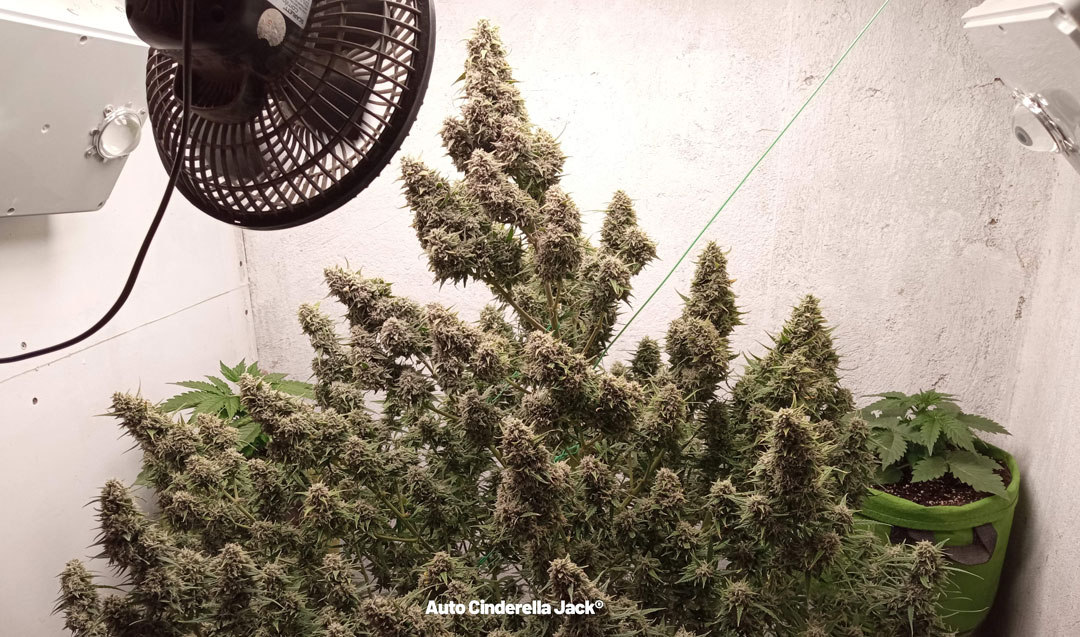How to detect and cure mould on cannabis

Disclaimer: This content is intended for educational purpose as well as for those who are legally allowed to grow cannabis. Laws and regulations regarding cannabis cultivation differ from country to country. We therefore strongly advise you to check your local laws and regulations before you consider cultivating cannabis yourself.
Mold (UK spelling) / mould (USA spelling) is a structure that certain types of fungi can produce. Cannabis mold can form on growing plants or on damp stored buds. The damage is devastating as buds turn to mush. Molds are technically considered to be part of the microbe family. Once mold is established it can be difficult to get rid of, but options are available. The experienced grower tends to view prevention as the best form of cure.
| Summary: | |
| ● | Main causes and consequences of mouldy weed |
| ● | What are the types of mould affecting cannabis plants? |
| ● | How to prevent mould in cannabis? |
| ● | Cannabis mould can affect your cured buds too! |
Main causes and consequences of mouldy weed
Molds perform a critical role in nature, secreting highly effective enzymes they biodegrade and recycle organic matter. Mold also appears where we don’t want it - e.g. on stored foods. Salting, pickling, bottling, freezing, drying etc are all strategies used to slow the progress of mold.
Mold requires moist conditions to survive and thrive. Stagnant air in poorly ventilated grow tents, coupled with warm conditions offers an ideal environment for mold to spread. It is generally seen in bloom when the buds are swelling, or in the jars if the buds were not correctly dried and cured. Mold can also strike outdoor & greenhouse cannabis plants if the genetics lack sufficient resilience for the conditions.
If a mold outbreak hits your cannabis plant in bloom you will need to act quickly to prevent loss of the entire plant/crop, whether it is an indoor or outdoor grow.
What are the types of mould affecting cannabis plants?
Several strains of mould can cause problems for cannabis growers. Some of these, such as botrytis are relatively well-known headaches. Other, such as white powdery mildew can be caused by a variety of moulds. All require moisture to thrive and, if caught in time, you have reasonable options to rescue your grow.
Botrytis

Botrytis, or grey mould, is one of the more common cannabis mold problems. She can strike healthy plants, but often favours infecting damaged plant areas - for example points where leaves/branches may have been removed, or split stems from e.g. cannabis super cropping. Botrytis spreads spores via airborne transmission, meaning that it is nearly always a potential threat.
Symptoms:
• Small black dots on infected plant areas are the first sign of botrytis infection
• Watch out for patches of fast-spreading grey mould on leaves and bud
• As the cannabis mould spreads, the leaf tips may show brown/yellow discolouration
• As botrytis spreads the leaves and blooms suffer catastrophic damage. THC rich buds transition into a slimy, foul smelling, mush.
• Warm, humid and stagnant environments (indoors or outdoors) offer ideal conditions for botrytis to spread. But botrytis will also spread in cooler conditions, such as Spring and Autumn (which often poses the greatest risk because of the heavy rainfall).
Cures & tips:
• Removal and disposal of infected plant areas is a must. Never leave any plant waste in your grow room (bury, bin or burn botrytis infected waste). Always try to maintain the highest levels of cleanliness. Regular cleaning and vacuuming of indoor grow tents/areas is recommended, as is a thorough clean-out, wipe-down and disinfection (e.g. with dilute Hydrogen Peroxide) between grows.
• If you see an infected plant part try to remove it. When using clippers/scissors, always sterilise after use - especially on a botrytis infected cannabis plant.
• Buy a humidity meter and monitor your grow room humidity carefully. Pay particular attention to maintaining low grow room RH (relative humidity) during bloom, aiming for 40-45% or below. Use of a grow room de-humidifier is an approach used by many serious growers. In some situations, de-humidifiers in combination with air-conditioning is the only way for indoor growers to maintain workable indoor grow conditions during hot/humid summer grows.
• Use a grow room fan (or two) to ensure no stale pockets of stagnant air, especially below the top canopy.
White powdery mildew

There are actually several cannabis mould strains that can produce powdery mildew effects, but all tend to be called white powdery mildew. If you see leaves that look like someone has split small amount of white talcum powder on them then you probably have a white powdery mildew infection.
Symptoms:
• The white mildew-affected areas degrade leaf function . Lower leaves tend to be first affected but powdery mildew can damage any plant surfaces above ground and will spread rapidly via air-borne transmission once established. Greenhouse cannabis growers are particularly at risk of powdery mildew.
Cures & tips:
• Affected plant areas can be wiped with a damp cloth and very carefully monitored. Badly affected areas can be carefully removed and burnt/buried - always remove infected material from the growroom/greenhouse. The most effective non-conventional methods of control against powdery mildew are to spray with milk, dilute Potassium Bicarbonate, natural sulfur/sulphur, metal salts, and oils such as neem oil. Various chemical fungicides are available but are only used by the most unscrupulous cannabis growers. The main concern about fungicide use is, of course, the potential safety issues when the buds are later vaped, used in a joint or eaten.
• But prevention is better than cure. Ensure good air circulation around your plants, use clip-on fans to eliminate any pockets of stagnant air and use an appropriately sized extraction fan in your grow area. More space between your plants and use of a dehumidifier in your grow room may help.
• Outdoor growers may wish to use less dense planting arrangements and grow in full sun, eliminating sources of shade.
Root rot

Cannabis root rot can occur when roots are grown in a low-oxygen (‘anoxic’) conditions which causes them rot. The cannabis root system is essential for healthy growth above ground. So when root rot is established growth stops. In the worst cases, root rot can devastate your plant and harvests.
Symptoms:
• Leaf discolouration and stunted growth are the tell-tale signs of root rot. For less experienced growers, over-watering (and over-feeding) is one of the more common rookie errors.
Cures & tips:
• There is no real cure for root rot. Once fully established your only real option to save your crop is to take cuttings and improve conditions for the subsequent grow.
• Root rot is predominantly caused by a few strains of water moulds. It’s important to note that these mould strains can’t thrive without adequate moisture levels. Therefore it remains good advice to use avoid over-watering and to use highly aerated grow containers such as air pots or felt sacks.
• Growers using cannabis hydroponics are better placed than most to regularly inspect root health during routine reservoir/nutrient changes. Any hint of emerging root rot can often been seen (and perhaps smelled) a little earlier in hydro than with e.g. soil. Often hydro growers can resolve the situation with improved aeration (e.g. larger air pump/air stone), a good clean and fresh nutrients.
Sooty mould

One of the more visually disconcerting moulds is sooty mold/sooty mould. It is a dark sooty appearance which affects leaves but, in minimal outbreaks, causes limited other damage. In cannabis, sooty mold restricts the photosynthetic capacity of the leaf. It is caused by fungal growth on the sugary waste produced by certain insects, pests and aphids.
Symptoms:
• Patches of snotty/mucous looking deposits on leaves and buds
Cures & tips:
• Affected leaves can be wiped clean or removed from the grow room.
• The root cause of the problem - insects/pests & aphids need to be removed. Use of beneficial cannabis insects and predators is one way to approach the situation.
How to prevent mould in cannabis?
The astute and accomplished cannabis grower pays great attention to both optimising their grow room conditions as well as regularly improving them. At the minimum, you need to regularly monitor temperature and RH (Relative humidity) in your grow room. A hygrometer is inexpensive and can monitor both. The next step is to identify areas for improvement and implement them.
Expert indoor growers are aware of the variations in environmental conditions throughout the year. That may mean consideration is given to air-conditioning and de-humidifiers at certain times of the year or at different stages in growth. For some growers it may mean that grows don’t take place at all if e.g. heat waves are inevitable.
Upgrading from HPS to LED will not only generally improve THC levels and terpene content, it may also reduce heat build-up in your grow room and allow cooler ambient conditions closer to optimum temperatures of around 24-25 Celsius (around 75F)
Some growers report that use of supplemental UVA/UVB lights also helps contain fungal outbreaks as well as helping with some types of pest control. Good housekeeping between grows is always recommended. Greenhouses and tents can be cleaned and wiped down with e.g. dilute hydrogen peroxide solutions to help disinfect between grows.
Remember that cannabis mold can strike during both vegetative growth as well as during the cannabis flowering stage. Monitor your grow room and try to avoid mould-friendly conditions.
Grow mould-resistant cannabis strains

Outdoor cannabis growers will be aware that the best outdoor cannabis seeds have been selectively bred for their robust outdoor growth. Strains such as Frisian Dew, Durban Poison, Shaman and others will give far superior outdoor performance/harvests than lesser strains that benefit from no outdoor selective breeding.
Buy your cannabis seeds carefully too, researching your options. The best cannabis seed suppliers work hard to deliver fine quality genetics but many seed suppliers have little idea how their genetics perform in real-world conditions.
Ensure optimal humidity levels
Especially when it comes to mould, prevention is better than cure. De-humidifiers are inexpensive and can be of significant help in reducing ambient humidity levels down to workable levels.
Air conditioning has traditionally been considered an expensive luxury that very few growers could justify. But with summer heatwaves becoming the norm for so many, air conditioning is rapidly joining a new LED growlight as the top item on many indoor growers wish lists.
Ensure optimal ventilation

Running an indoor grow operation with an under-powered extraction fan should be one of the top priorities for any indoor grower to fix. A more powerful extraction fan will help drag the necessary amounts of fresh air through your grow room and minimise the potential difficulties that are associated with lack of fresh air. Clip-on fans for use in less-ventilated areas of your grow (e.g. below the canopy) are also strongly recommended.
Prune and regularly inspect your cannabis plants
Some growers regularly remove lower branches and leaves, this can help combat some types of cannabis mould such as white powdery mildew and may also improve air flow. Regular inspections of your plants is always recommended. Dead leaves or suspicious-looking areas can be removed from the grow room and disposed of. Spotting problems in your grow room early is always preferred to allowing an infection to become stablished, at which point treatment options may be more limited.
| Related: |
| Visual guide to cannabis pests and disease |
Outdoor growers have less control over their environment. This means that choice of outdoor cannabis seeds becomes particularly important. Choose proven, reliable strains. It may help to grow them in raised beds if possible with full sunlight. Ensure plants are not too close together. You may wish to consider e.g. a tarpaulin cover to protect your plants from the worst of the (late season) weather and perhaps the worst of the mid-summer heat. Portable grow containers, whilst offering less root space than plants rooted in the ground, allow the grower to move their plants in the event of extreme weather. Use of trichoderma, a beneficial fungi, can help prevent the damaging fusarium mould taking hold.
Outdoor growers that experience issues with late-season cannabis mould when growing feminised cannabis seeds may wish to consider the use of autoflower seeds. These ripen much earlier in the season and may be a more viable alternative for some growers.
Cannabis mould can affect your cured buds too!

If you put damp buds in your jars you increase your chances of mold attacking them. In the worst cases this will ruin the buds with an ammonia-smelling mould. Always take care to ensure the buds are nice and dry before jarring them up!
| Related: |
| How to harvest, dry and cure cannabis |
It’s also worth saying that mould is a relatively rare worry for those growers with a well controlled grow room, with good ventilation, humidity levels, extraction and air circulation. Set up your grow room well, understand how conditions vary throughout the year and do your best to optimise conditions. Your time will be very well spent!
Can you smoke cannabis buds that were once mouldy?
In desperation, some growers will try to sun-dry mouldy buds that they may have found in their jars. But are they safe to use? Most growers would avoid the buds out of fear of the potential health/lung dangers that could come from the mould/spores.




























